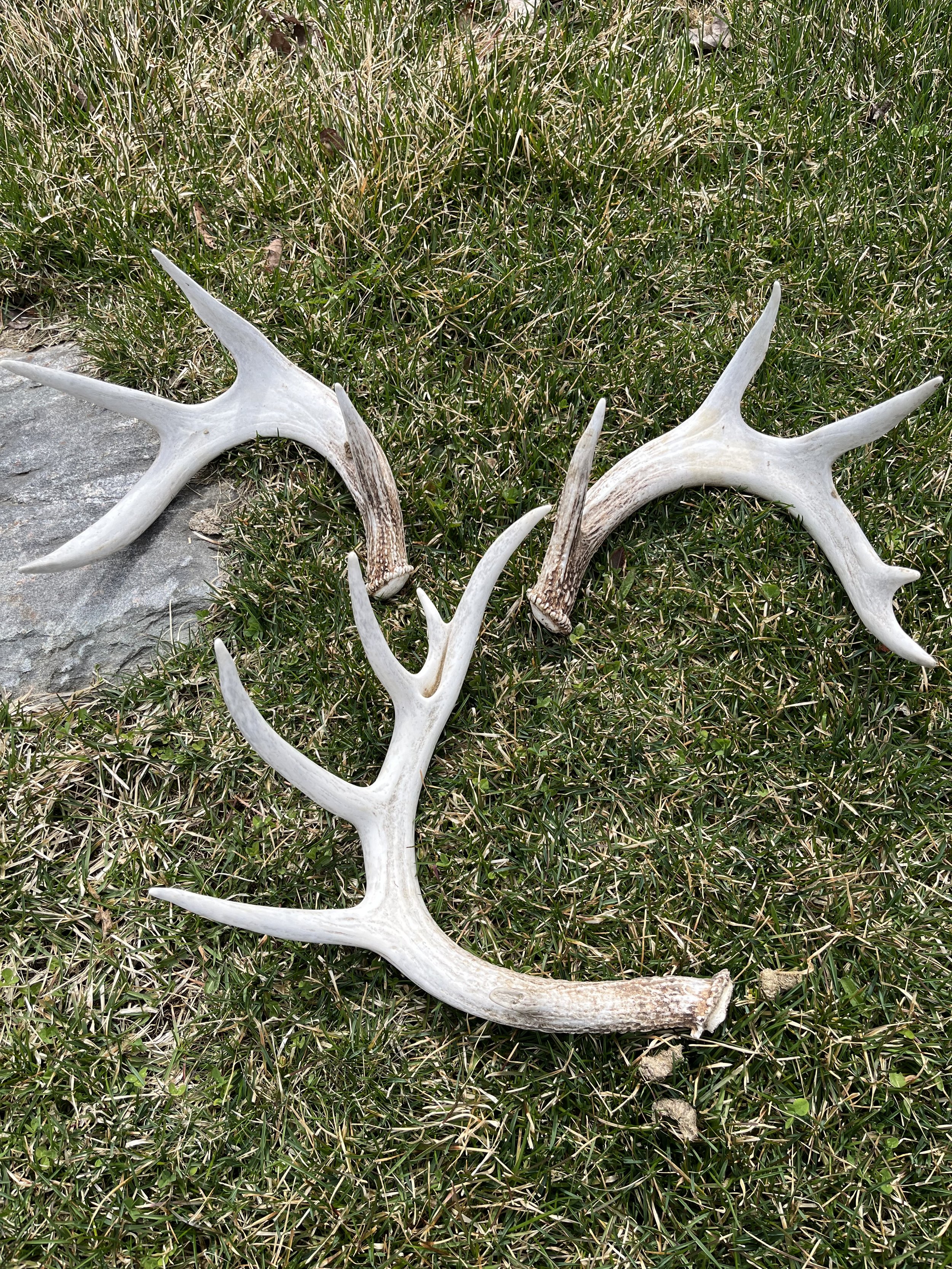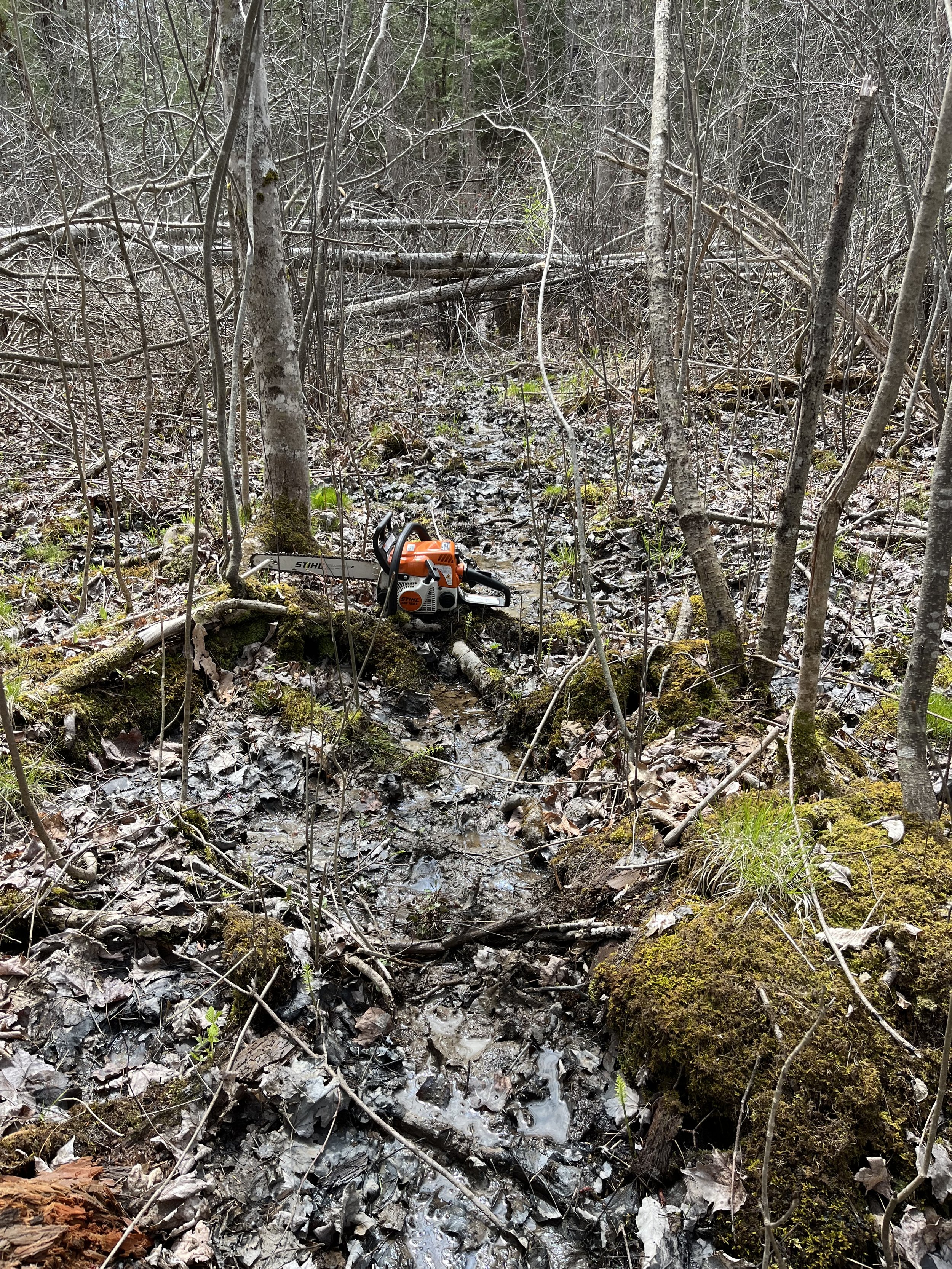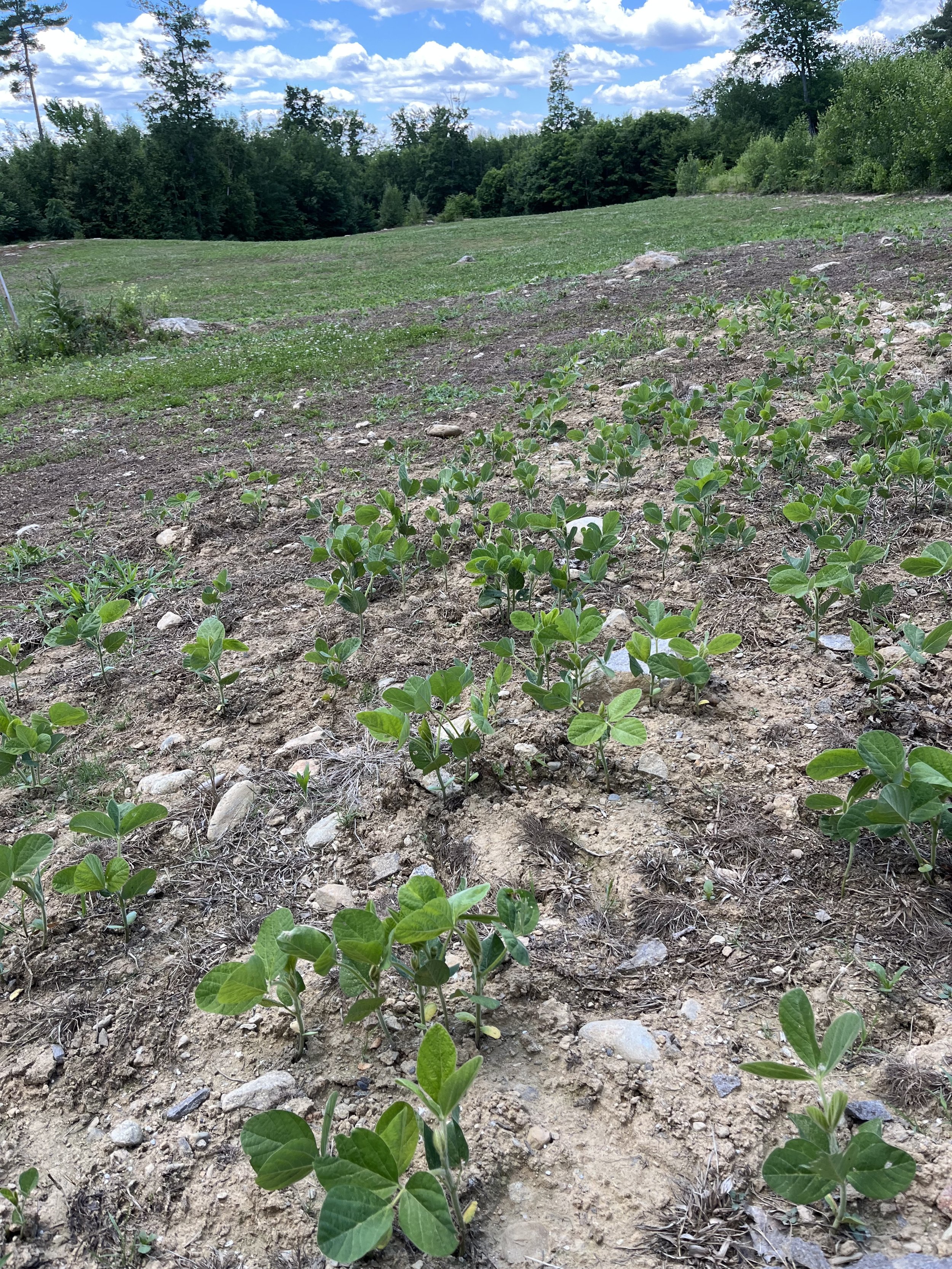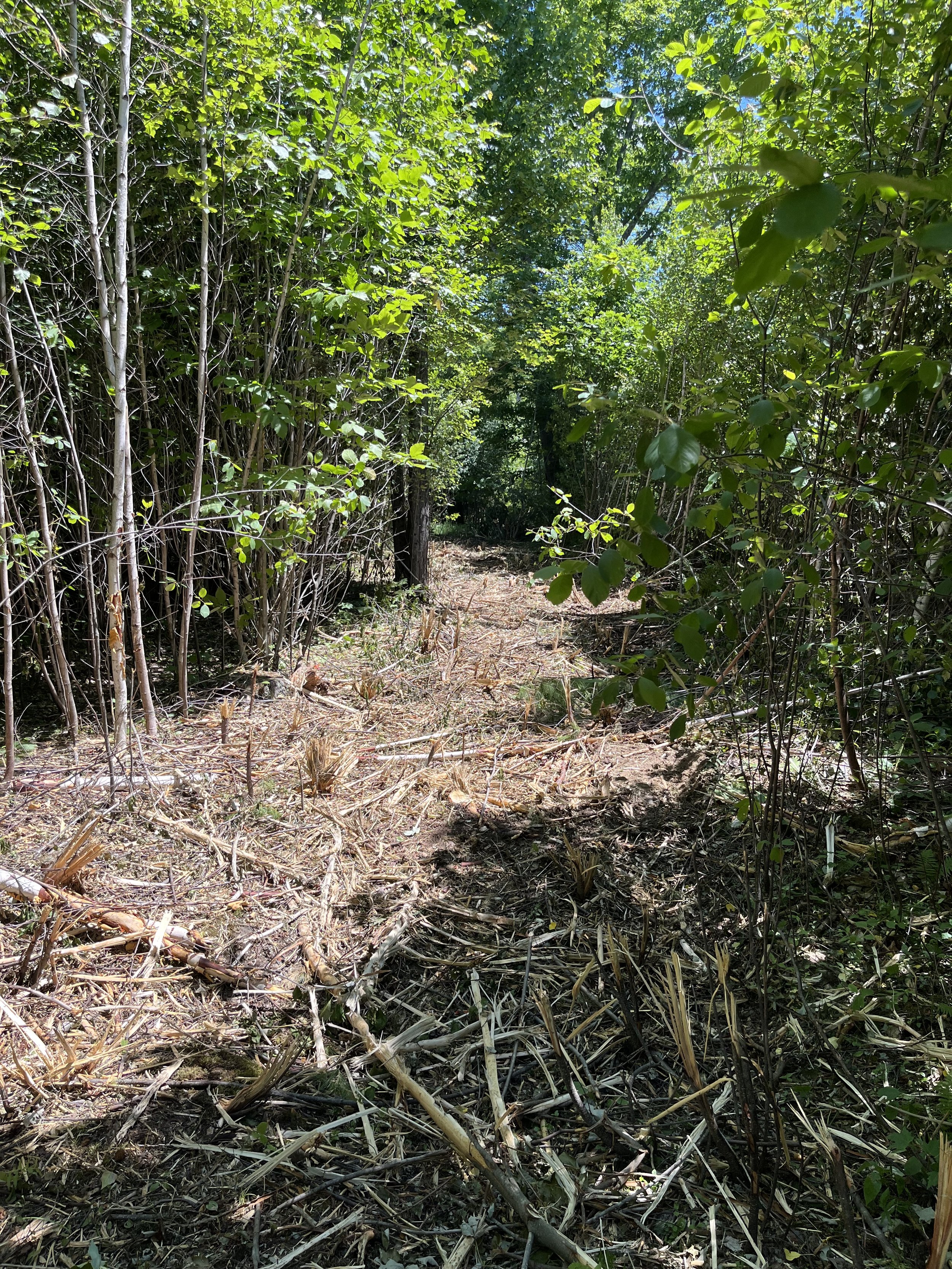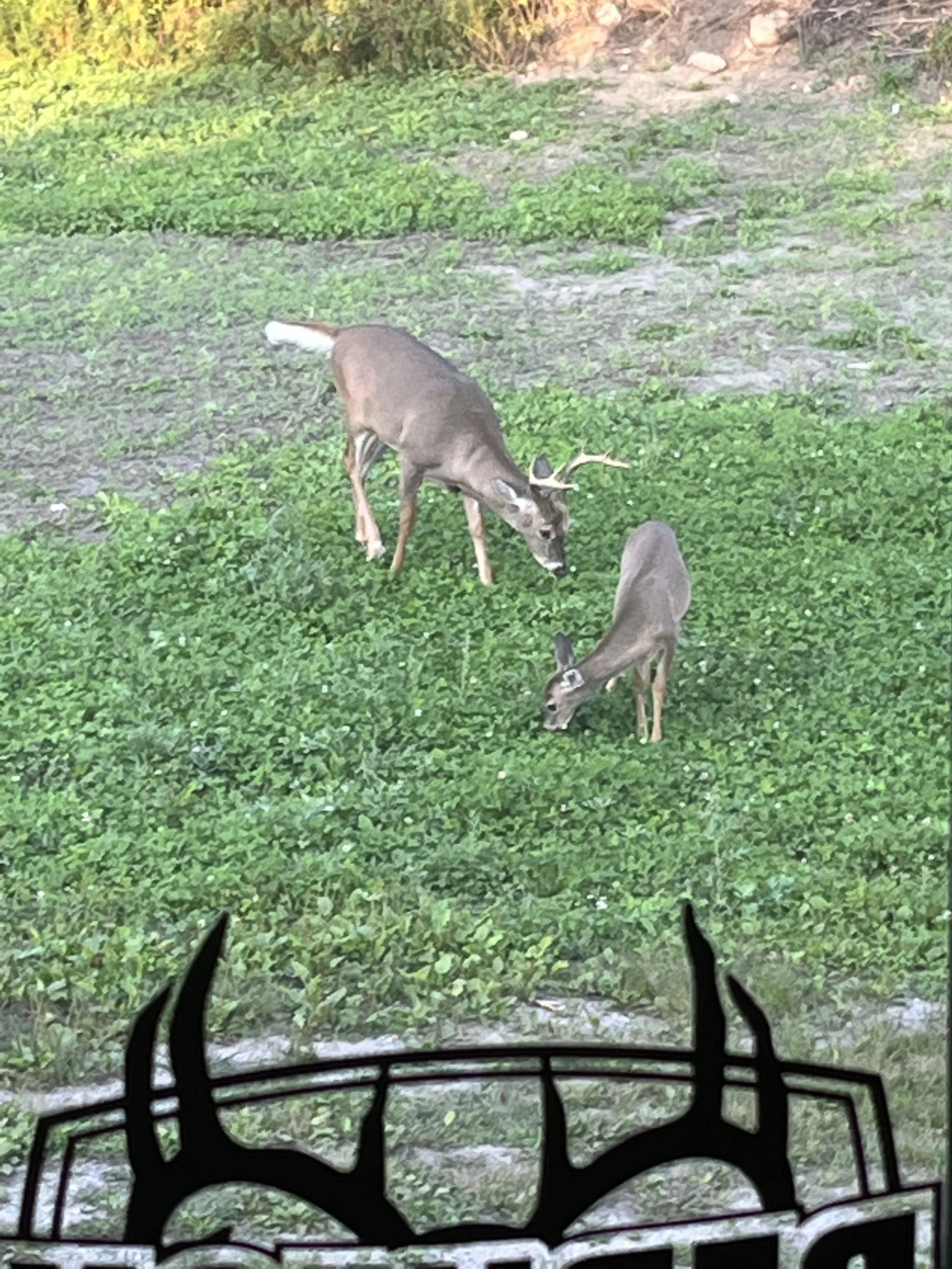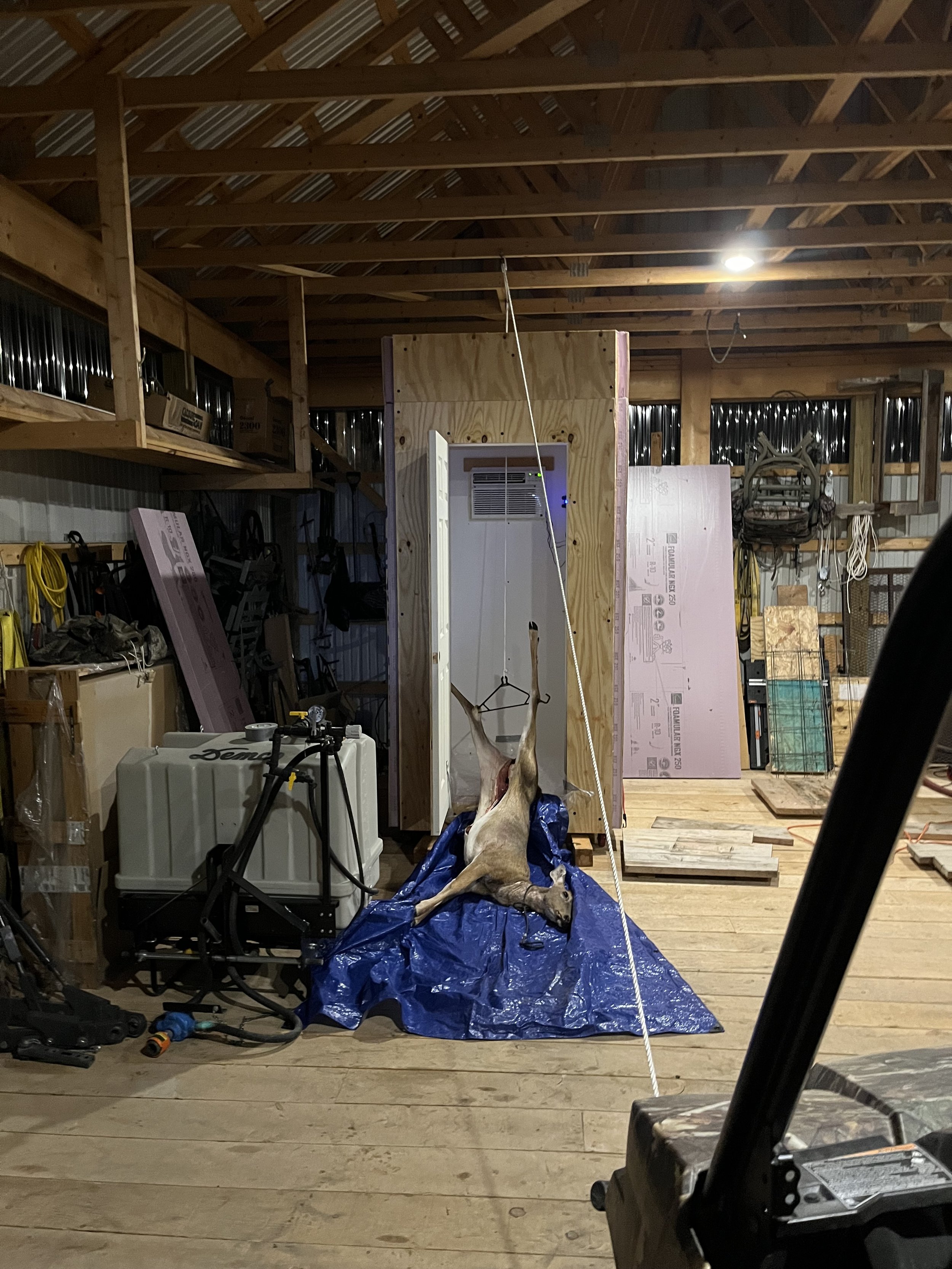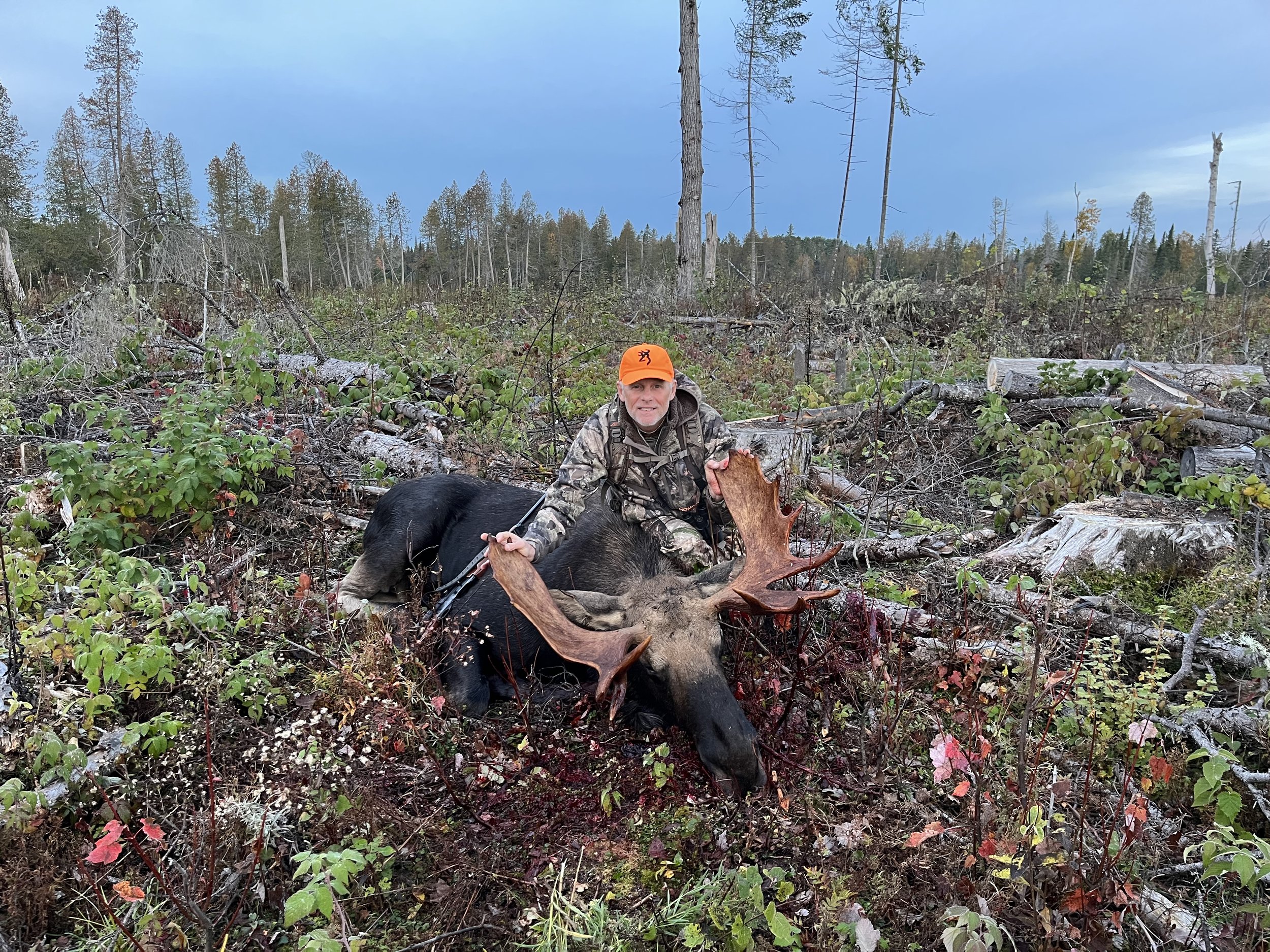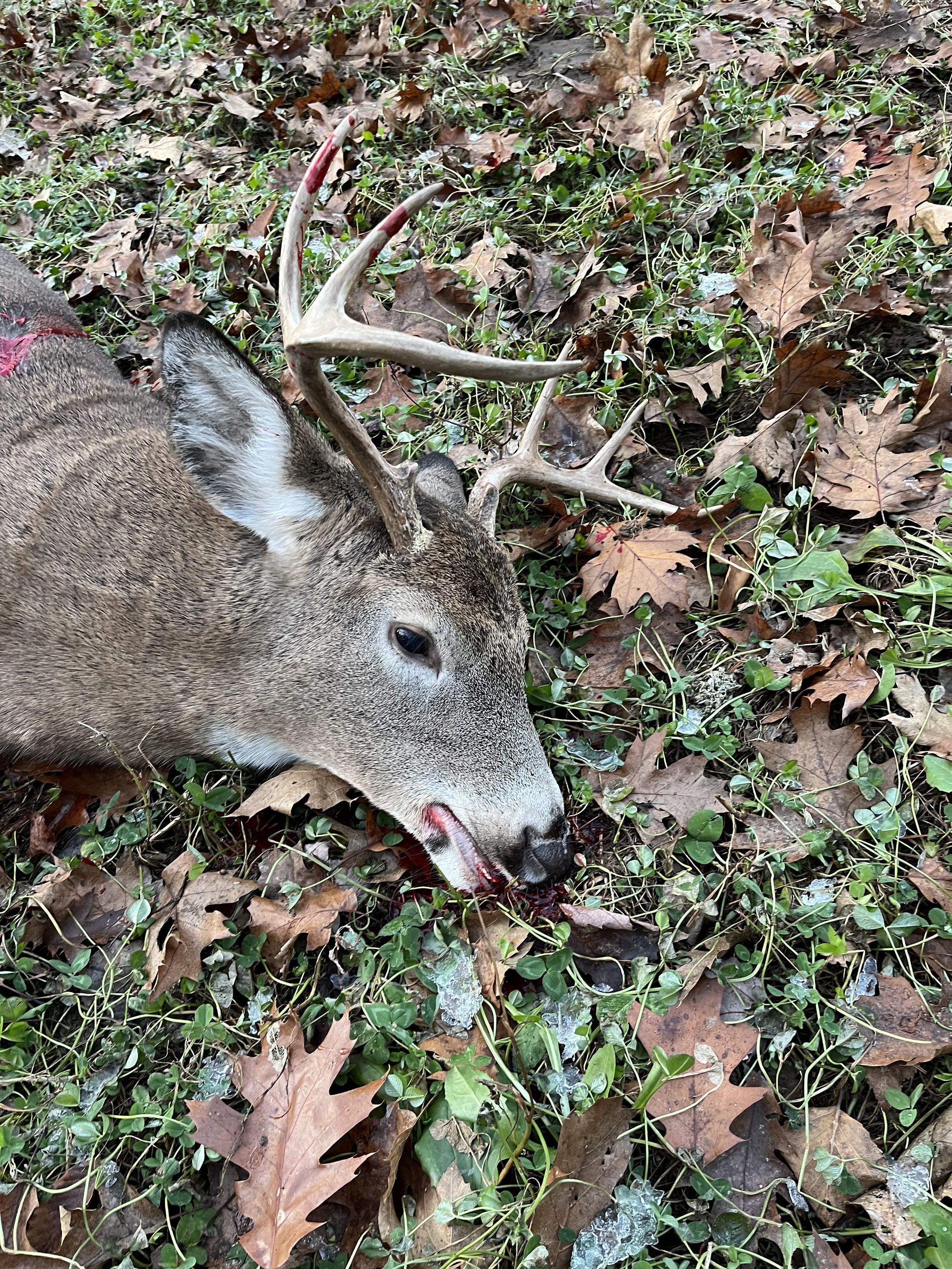2022 Land Management Case Study
2021 was an awesome year and I started 2022 with a bunch of plans to improve this 108 acre parcel. I shot my second buck of the 2021 season on November 20 and decided to stop hunting, so I then had the rare opportunity to do my scouting and planning for the next year while the hunting season was still going. The light snowfall during this period enabled me to see in detail exactly where the deer were traveling, and even showed me where they were able to “leak” through some of my barriers and avoid my stands.
As you can see on the 2022 plan to the right, I had a small amount of hinge-cut barriers planned, a lot of trails to cut, and six new treestands. The trails to be cut were mostly intended to give bucks cruising during the rut an easy route to stay on my land while they travel between bedding areas, and pass by each of the six new treestands. I walked all of the areas and flagged where the trails would go. Most of the new trails will be able to be cut with my forestry mulcher - if it wasn’t for this machine I wouldn’t be planning such an ambitious network of trails.
The new treestands should solve a problem I have had - a shortage of good stands located back in thick cover or woods where rutting bucks will cruise during daylight hours. The two located near each other at the north end of the property will be on the north side of a large and active bedding area called The Swamp. Each stand will have a trail to sneak in on, and they will be for hunting a south wind. The new trail in this area should attract bucks that want to cruise the down-wind side of the bedding area, scent-checking for does, and the tangled mess behind these stands will keep the deer travel upwind of the stands.
The Genesis 5 No-Till Drill looks awesome
The two stands planned to be next to each other to the northeast of Big Field are on opposite ends of an old cattle fence that runs through the woods along the property line. Depending on the wind, and the deer action I see on the trail cameras, these stands will be in a good position to intercept deer going from bedding to feeding, passing by either end of the fence. They will also be within 20 yards of the new “Ring Road” trail that will run all the way around Big Field - the Ring Road will be a new trail cut with the mulcher that will enable bucks to stay in cover while they scent-check the field and the bedding cover that lies between the field and the main road to the south.
A new stand will be located on the south side of the property, between the neighbor’s house on the main road and the field, and will allow me to hunt deer traveling both the Ring Road and the nearby gap in the field berm. The sixth new stand will be back in the woods to the west of the Big Field. Located at the bottom of a sharp drop-off and next to the creek, the Creek Stand will intercept bucks traveling the Ring Road from both directions, as well as another new trail that runs east/west between the Big Field and the western property line. All of these trails are located on existing deer travel routes, just cleared to make them the new path of least resistance.
Sheds lying in the Big Field
For the past two seasons I have had tremendous success planting an annual crop in two acres of Big Field. In 2020 I had put in soybeans, and last year it was a brassica blend - both produced forage that was amazingly attractive during the hunting season and into the winter. However, both also required me to till the plot and rake the rocks and chunks of wood, along with all the good organic material, off to the side and dump it onto the berm. It was a time-consuming, dusty and dirty job that actually reduced the soil quality. I had been reading about another way, a better way, to plant food plots that used a no-till drill to plant seeds right through the existing organic matter. In 2021 I not only tilled the Big Field plot, but also the new plot by the RN2 blind, the Grove plot, and West Exit. That was just too much! I bought a Genesis 5 No-Till Drill in November with the plan to start using it in the spring.
Hinging trees to block a trail can force deer to abandon this exit and move past your stands
Another concern I have is the quality, and carrying capacity, of the bedding areas on my land. Most of the existing bedding is in areas that were logged about 15 years ago, and have since grown-up into thick hardwood regeneration. My concern is that the hardwood regeneration has now formed a thick canopy that is shading out much of the forage that deer need during the day for food. Also, there isn’t a lot of “side cover” that deer like to have to keep them hidden from predators. I have been researching this issue and, if I have time, I plan to create better bedding areas in several places around my land.
I started in April by frost seeding many of my clover plots and preparing my new treestands. The ground had just started to green up, so it should have been a good time to spread clover seed. However, I monitored the seeded areas throughout the year and I didn’t notice a difference between them and other clover plots. Spraying seems to be the best way to maintain the clover - I spray a mixture of grass specific and broadleaf weed specific herbicides as early in the year as the soil allows. The herbicides attack unwanted weeds but are designed to not hurt the forage I want. They seem to do a good job knocking down the grass and weeds so the clover and alfalfa can thrive.
Parts of the Ring Road needed to be cut by hand
When walking the land just after the snow melted I found three sheds from two mature bucks - all three were just lying in the Big Field! Two were a matched set that had fallen close to each other - they were distinctively bladed and came from a deer I knew well. The other was the left side from one of a pair of older bucks with longer tines that I had on camera in December and January - the bodies and antlers were so similar in size that it was hard to tell that these were actually two different bucks. The antler I found was from a buck that I caught on camera January 21st after he just dropped the right side - he was heading up to the Big Field where he would shed the left side that I found. I looked all over the area and never found the right side, and I never found the set from the other big buck.
When I scouted the land toward the end of the 2021 hunting season I could see where deer had been able to get through a few of my hinge-cut barriers, and I marked the areas with flagging. So in early May I went back in with my chainsaw and hand saw to block those weak areas. The barriers don’t have to be perfect - I actually think that it is best if deer could jump through them if being chased by a predator - but they can’t be easy to get through. Every patch of woods or thick bedding area should have a cut trail that is the path of least resistance. When deer leave their beds to feed they should take one of the cut trails, and that trail should lead them by a stand or blind.
I blocked the flagged gaps, blocked the corner just south of the West Exit plot, cut a barrier behind the tree stand in the western corner of Big Clover, cut a barrier behind the barn, and cut a large barrier leading down from the berm in the western corner of the Big Field. I removed the treestand in the corner south of the West Exit plot because it just wasn’t a good spot to hunt, and put in a new treestand down by the creek below the western corner of the big field.
No-till drilling soybeans into the Big Clover / Central food plot
I always do my most strenuous projects in May and June when the weather is cool and the ground is still too soft to work with heavy machinery. The Ring Road was my project to cut a trail that would go all around the Big Field and encourage bucks to cruise this route during the rut when they would want to check all the does living around the field. The plan was to have a total of eight treestands and box blinds along this route, giving me plenty of options to hunt various wind directions and patterned deer movements.
The eastern side of the Ring Road would need to be cut by hand because the trees were large and the ground fades into a swamp. Using a chainsaw, tractor, and UTV, I cut a road that was mostly passible by UTV until it went into the swamp. The southeast corner went through a grove of white pines that were leftover from when we first bought the land - the Big Field was seven acres of those pines before I reclaimed it. I used the forestry mulcher along the south side of the property to cut the Ring Road through an area of saplings and connect it to the pine grove. This area on the south side of the property has the remains of a homestead that I found the previous fall when scouting after the season. Fallen down house, chimney, and barn. The homestead is now home to a perennial deer bedding area that usually contains at least one doe group.
Soybeans emerge in rocky soil during drought
The ground in many of my food plots had firmed up by the middle of May and I was able to spray. I usually spray a mixture of Arrest (for grasses) and Slay (for broadleaf weeds), but the past couple years I have substituted Clethodim (the active ingredient in Arrest and a fraction of the price) for Arrest - I sprayed this mix on any clover food plots that were firm. Later in 2022 I switched Slay over to a cheaper alternative with the same active ingredient, Imazethapyr.
For my annual food plot portion of Big Field, as well as all of Big Clover, I sprayed a generic version of Roundup (glyphosate) to prepare these plots for soybeans to be planted with the new grain drill. The glyphosate would kill the weeds and volunteer forage on the 2 acres that had been in brassicas the previous fall, and it would (hopefully) kill the clover growing on an additional acre in Big Field, and the two acres of Big Clover.
Since Big Field is not a very creative name, and since Big Clover is not really that big and will no longer be planted in clover, it is time for a couple name changes. Going forward, Big Field will be named Homestead - named for the old cellar holes and well found next to it last fall. And Big Clover will be called Central - it is located roughly in the center of the property. I will use both names this year and then use just the new names in 2023.
One of the new trails for bucks to cruise during the rut
I have been following the teachings of Dr. Grant Wood on his Growing Deer website and this is the year that I switched over to his regenerative farming methods for part of my food plots. Wood advocates using a no-till drill to plant food plots, along with planting two times a year in order to always have something in the plots available to deer. A no-till grain drill enables the seed to be planted right through whatever is in the field, so you don’t need to disturb the soil by chewing it up with a disk harrow. The organic material remains on the field as a mulch and slowly rots as the new plants emerge. The rotting vegetation fertilizes and builds the depth of the soil, saving money and storing carbon.
The glyphosate knocked down the clover on the three acres that I was converting to the new no-till methodology, but it didn’t kill it like it did all the weeds in these plots. That actually seemed like a benefit because the stunted clover provided some deer forage while it sheltered the emerging soybean plants. Unfortunately we had a drought for most of the summer so I never saw what might have happened in favorable growing conditions. Despite the drought, the soybeans did ok. The plots with clover or alfalfa burnt out while grasses and weeds did a bit better, and the soybeans held their own - the soybean “seeds” are large so the plants get off to a good start, the roots are deep, and the leaves seem to catch a lot of available moisture from dew.
Fall blend growing among browsed soybeans
The dry summer enabled me to cut more trails with the forestry mulcher, especially in the wetter areas at the north end of the land behind the barn. I call this area the Swamp, and it usually has one or two doe family groups bedding there during the hunting season. I was able to cut two north/south trails that would connect together and run south to the Big Clover / Central food plot, as well as an east/west trail designed to give bucks a cruising path during the rut. I also cut a deer trail from the Garden plot to the Ledges plot - I cut the trail in the morning and had deer on camera using it in the afternoon.
Using the skid steer and mulcher combo is always a stressful thing, especially when operating in thick hardwood regeneration where the ground can be wet. This northern part of my land was never good farm land - at best it was marginal pasture. There are stone walls, but the ground has been beat-up by logging equipment after the farm failed, and there are larger rocks, ruts, and old stumps. I caught the track on a stump when turning around and found out the hard way how to put the track back on a 5-ton skid steer.
View from the new Barn blind on opening day
During the summer I put up the remaining five treestands called for in the 2022 plan, as well as two new Redneck Buck Palace box blinds on ten foot towers. The first blind went up right next to the barn - some of my non-hunter friends asked me where I planned to locate it and were surprised when I said, “right where it is.” I have the Barn and Garden food plots that form an”L” shape around the barn and I have had three treestands to hunt the area. The deer pattern me and know that I am not working around the barn in the afternoon during the hunting season, so they come out to feed before dark. The problem is that the local deer bed throughout the surrounding woods and come to those plots from every direction and so the wind is always going to be wrong. The new blind located in the inside corner of the “L” will allow me to keep the windows closed and my scent inside as deer browse all around me.
The second blind was located in the Ledges food plot that’s about 150 yards south of the barn. I have shot four deer from the treestand at Ledges, so it’s a very productive food plot. However, the stand is not high enough in the tree so deer have “busted” me multiple times in the past. It also has the same problem where deer can come from any direction, so a box blind was the obvious solution.
In mid-August it was time to drill a fall blend into the standing soybeans. This was nerve-wracking because it seems wrong to run a grain drill through a beautiful crop of lush beans - however, you only lose a portion of the soybeans and you gain a new crop that will be even more attractive during the hunting season. I planted the Buffalo Fall Mix from Eagle Seeds, containing rye, radishes, annual clover, brassicas, buckwheat, soybeans, and wheat. This blend is designed to grow fast, be attractive during the fall months, and also start growing again in the early spring.
Pulling a deer into the cooler
As the summer came to a close and the hunting season approached I finished a project that had taken me weeks - a refrigerated deer cooler. One good thing, as well as a problem, with hunting deer in the early season is that the temperatures are warm and the days long. Great for being comfortable sitting in a treestand, but the problem is by the time you shoot and recover a deer it’s usually late and the tagging stations that register the deer are closed. It’s warm out, you can’t tag the deer, so you take it to your butcher and hope that he is around and can put it in his cooler. Then you come back the next morning, put the deer back in your truck, drive to get it tagged, and bring it back to your butcher. If any part of this process fails, you have a spoiled deer. My venison always gets rave reviews because it doesn’t have a gamey taste, and the key to that is getting it cooled down ASAP.
Research online led me to the CoolBot website where I bought a controller that would allow me to trick an air conditioner to operate at temperatures cold enough to keep meat fresh. I built a 4x4x8 insulated box with a door on one side and the controlled A/C unit on the other, putting the whole thing on casters so I could move it around inside my barn. I finished and tested the cooler on September 8th - just in time for the opening day of the Maine Expanded Archery season September 10th. To see how I made my deer cooler, Click Here.
I finished my new deer cooler just in time for opening day
I always like to start the season hunting in areas where I can get in and out without alerting the deer - hunting the outside perimeters first, and then moving in deeper as the season progresses. The deer are used to me coming and going around the barn, and I usually have several doe families living in that area so, unless I have a trophy buck patterned somewhere else on the property, the barn area is where I will start the season.
Opening day was ridiculously hot! The thermometer in the truck showed 83 degrees outside when I climbed into my new Redneck box blind next to the barn - inside the closed-up blind it was much hotter. I shed my clothes down to my underwear and was still soaking wet. I could see a deer in the thick brush to the north flipping its tail to shoo away the bugs, and 15 minutes later a doe and fawn fed into the plot. I was so wet that I couldn’t use my binoculars without fogging them up, so I opened the windows for a while - only when the sun went behind the trees was it cool enough to close everything up. Over several hours I had five deer in front of me and I could have shot any of them. Two fawns, a doe, and two bucks - one was a hard-horn three-year-old six-point, and the other was a younger seven point still in velvet.
The adult doe came back into the Barn plot at 6:00 and finally fed into a position where I could shoot. I ranged her at 32 yards and shot her through the vertical corner window - she ran off to the north and through a gap into my neighbor’s field. The two fawns and the two bucks spooked from all the commotion, but then they settled down and went back to feeding. The fawns were right in front of me, the bucks were over on the south side edge of the Garden plot, but neither party wanted to leave! After about an hour I started to make noises, trying to throw my voice toward the north, trying to make the bucks leave without seeing me climb down from the blind. The fawns were about 10 yards away and would look up at me when I pretended to be two guys talking to each other, but the bucks at 70 yards stayed put. Finally a few loud deer blows made the bucks leave toward the south, but the fawns didn’t go anywhere until I packed up and actually got out of the blind.
When you draw an unexpected moose tag you just have to go for it!
I recovered the doe and immediately field dressed her. It was now getting late, and it was still quite warm, so I hung her in the new deer cooler. I designed the cooler to have a gambrel attached to a line that runs through a hole in the ceiling, through two pulleys, and then to a loop that hooks to the front bumper bar of my UTV. After I hook the gambrel to the deer’s leg tendons, I just back the UTV up and it pulls the deer up into the cooler where it hangs until I’m ready to take it to the butcher. The cooler kept the deer at 37 degrees overnight, and in the morning I took it to Audet’s to register it and then to Sam Burgess to be butchered. Slick!
My November 9th monster buck
I “accidentally” drew a 2022 Maine moose tag for the first season starting the last week of September. I had put in for the tag because my friend from Wisconsin really wanted a trophy bull - I already had a really nice bull and wasn’t looking for another, so Jeffrey would be my subpermittee and actually shoot the moose. The accident happened when Jeffrey drew his own tag for 2022, and now we had two! So I decided to hunt for another bull, and my friend Todd Harrison volunteered to be my guide. We had a great time and, thanks to Todd and his crew of amazing helpers, I pulled it off. Hunting was really hard - Zone 1 just didn’t seem to have many moose. I hunted for the first three days with my bow, and actually had a small bull at 4 yards on the evening of day one, but I switched to my 30-06 and shot a medium-sized bull on Saturday morning - we felt lucky to find him. Jeffrey was guided by OMM Outfitters and shot a Boone & Crockett monster 10 minutes into the second season. No shortage of meat for us in 2022!
Neighbor shot later that same day
After opening day and the moose hunt I hunted my land hard for the rest of the season - a total of 26 days. I had some amazing hunts, seeing deer on all but three of the days. The box blinds were a huge help because several times I had bucks chasing does all around the blind and they never spooked because they didn’t know I was there. The only issue with a box blind is really getting out of it at the end of the day - you need to know where the deer will be and make sure that they won’t see or hear you, and especially not be downwind.
Early in the morning of November 9th I got a true monster on camera crossing in front of the Redneck blind up by Big Field / Homestead. I looked forward to hunting from that blind as soon as the wind was right, hoping that he might come back. I only hunt that spot when the wind is out of the south because, after the deer are in the field and it’s getting dark, that south wind will blow my sent away from the field. The deer may hear me, but they won’t know for sure what I am. Unfortunately a friend of Todd’s who lives about a mile away shot him later in the day on the 9th!
“Ground shrinkage” on this buck
On the afternoon of November 18th I was in a treestand looking over the Grove food plot. The whitetail rut is at its peak this time of the year - last year I shot my two bucks on the 15th and 20th of November. Does are now being bred and bucks are cruising the woods looking for the next doe to come into estrus. The Grove treestand is positioned to be close to any deer traveling between the bedding area to the west and the Grove food plot, the surrounding woods, or the Big Field / Homestead plot to the south. At 3:45 I caught a glimpse of a buck walking toward me on the cut trail that bisects the bedding area. He looked like a mature buck with a wimpy rack so I grabbed my bow and prepared for a shot. He walked out of the trail and turned to walk across the plot in front of me. I only had enough time to note his body size and pronounced tarsal gland staining, making the quick decision to draw and shoot because I thought he was at least 4 1/2 years old, my new minimum age requirement.
I had ranged the end of the trail and berm to be about 30 yards from the stand, and I had my 30-yard pin on his vitals when I shot, but I didn’t realize that he had walked quite a bit into the food plot and was closer to 20 yards away - the arrow hit him high. Fortunately the shock of the hit dropped him right in the clearing. When I got down and looked at him I saw that he was younger than I thought - he was 3 1/2 years old at the most. I am sure that if I had had enough time to get a better look at him I would have passed.
I hunted during the balance of November and had some close encounters with lots of deer action as the rut came to a close. In early December I was in the treestand at the western end of the Big Clover / Central plot and had more than a dozen deer come and go in the food plot in front of me. A mature buck with a trophy rack came into the plot from the north and fed for the last hour of daylight. I studied him for a while with my binoculars. He was a shooter for sure, and I hoped that he would give me a shot, but he never got closer than 50 yards. With all the action of deer coming and going, and having a shooter in the field, it was one of the best hunts I’ve ever had.
2022 was another good year for my land management project. The deer population is healthy and growing, and the quality of deer keeps improving. I didn’t cut all the trails I wanted to, and I didn’t have time to improve the bedding areas, but I’ll tackle them in 2023!
To keep reading about my land management project, Click Here To Go Forward To 2023
To go back to the previous page, Click Here To Return To 2021


